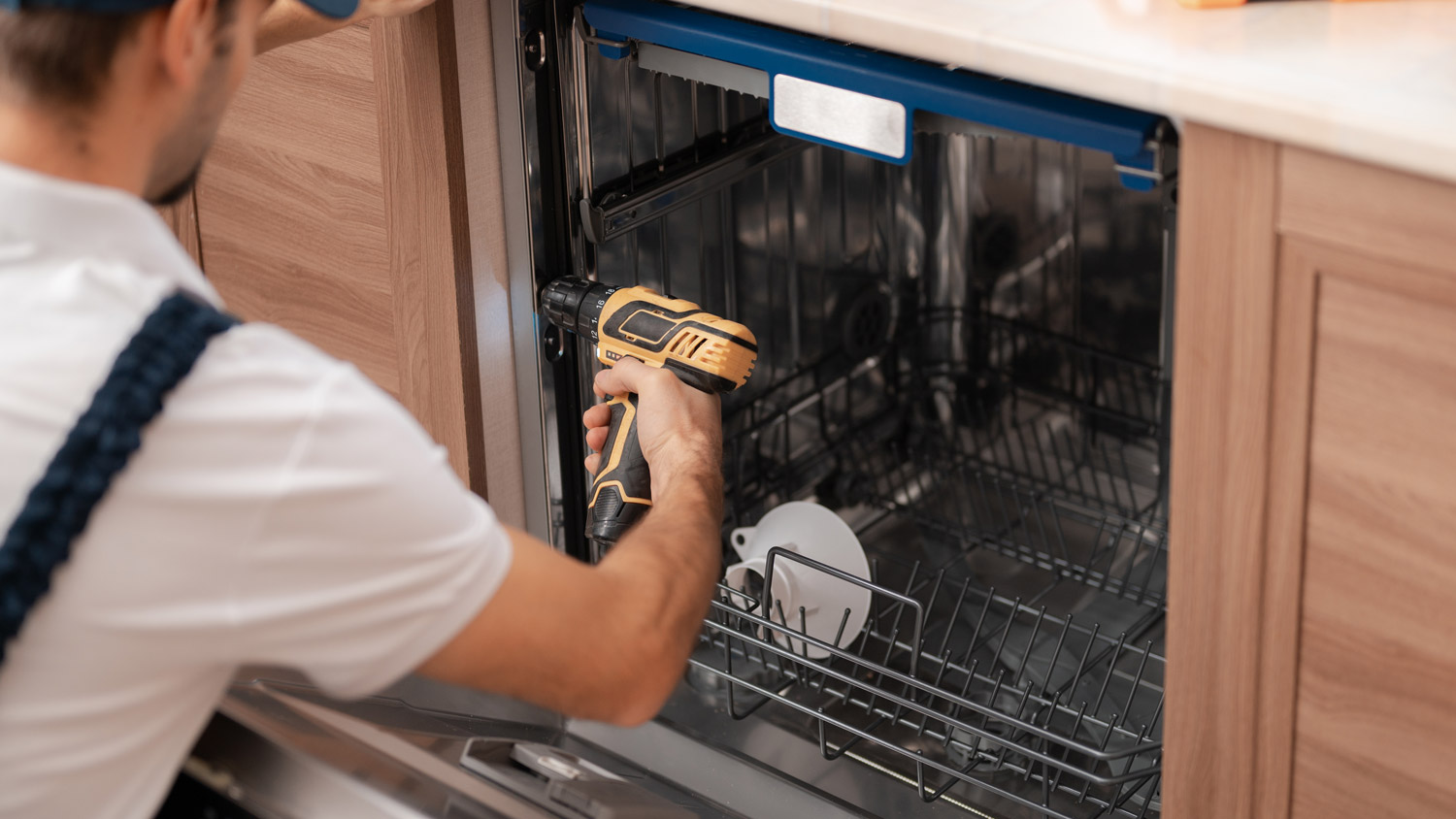
Discover the average dishwasher installation cost, key price factors, and tips to save on your project. Get transparent, expert-backed estimates.
The right refrigerator size improves efficiency and looks better in your kitchen
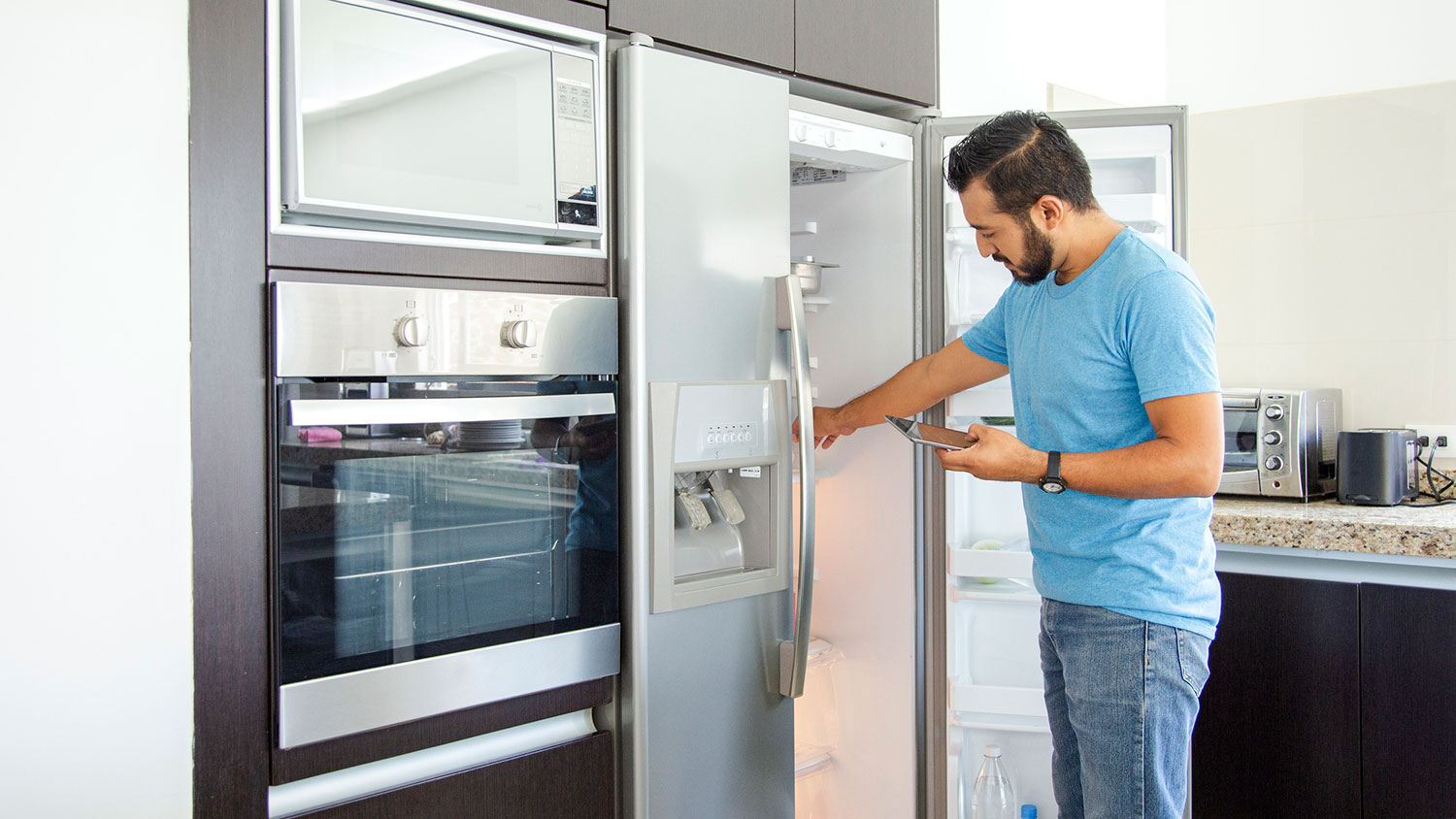

Standard refrigerator sizes vary by dimensions, style, and capacity.
Each adult requires 4 to 6 cubic feet of refrigerator space for groceries.
Standard-depth refrigerators offer more cubic space than counter-depth refrigerators.
The kitchen is the heart of the home, so when it comes time to replace your fridge, it’s worth putting the time and effort into choosing the right refrigerator size and style for your household. Believe it or not, there isn’t one standard refrigerator size; instead, they come in various depths, widths, and heights to fit into your countertops and kitchen layout, In this guide, we’ll explain the common refrigerator sizes and help you decide which size fits in your kitchen and will store enough food for you and your family.

Let's start with the basics. Whether you’re upgrading your fridge size or replacing your old appliance because your fridge is dying, begin by considering whether you need a small, medium, or large refrigerator. We'll discuss each fridge size and its measurements below, but on a basic level, here's what you can expect from the three standard sizes.
Small refrigerators: These typically measure 24 inches wide, 60 to 75 inches high, and 29 to 33 inches deep. Their thin yet tall shape is ideal for apartments and kitchenettes. These are the most likely to come in counter-depth dimensions vs. standard-depth dimensions.
Medium refrigerators: Medium refrigerators usually measure about 33 inches wide, 65 to 75 inches high, and 30 to 36 inches deep. These dimensions allow for a wider range of configurations for medium to large kitchens. In some cases, they come in counter-depth options.
Large refrigerators: When you have plenty of space to play, opt for a wider fridge with a larger capacity. Larger fridges measure around 36 inches wide, 60 to 70 inches high, and 30 to 36 inches deep. You’re least likely to find large fridges in counter-depth options.
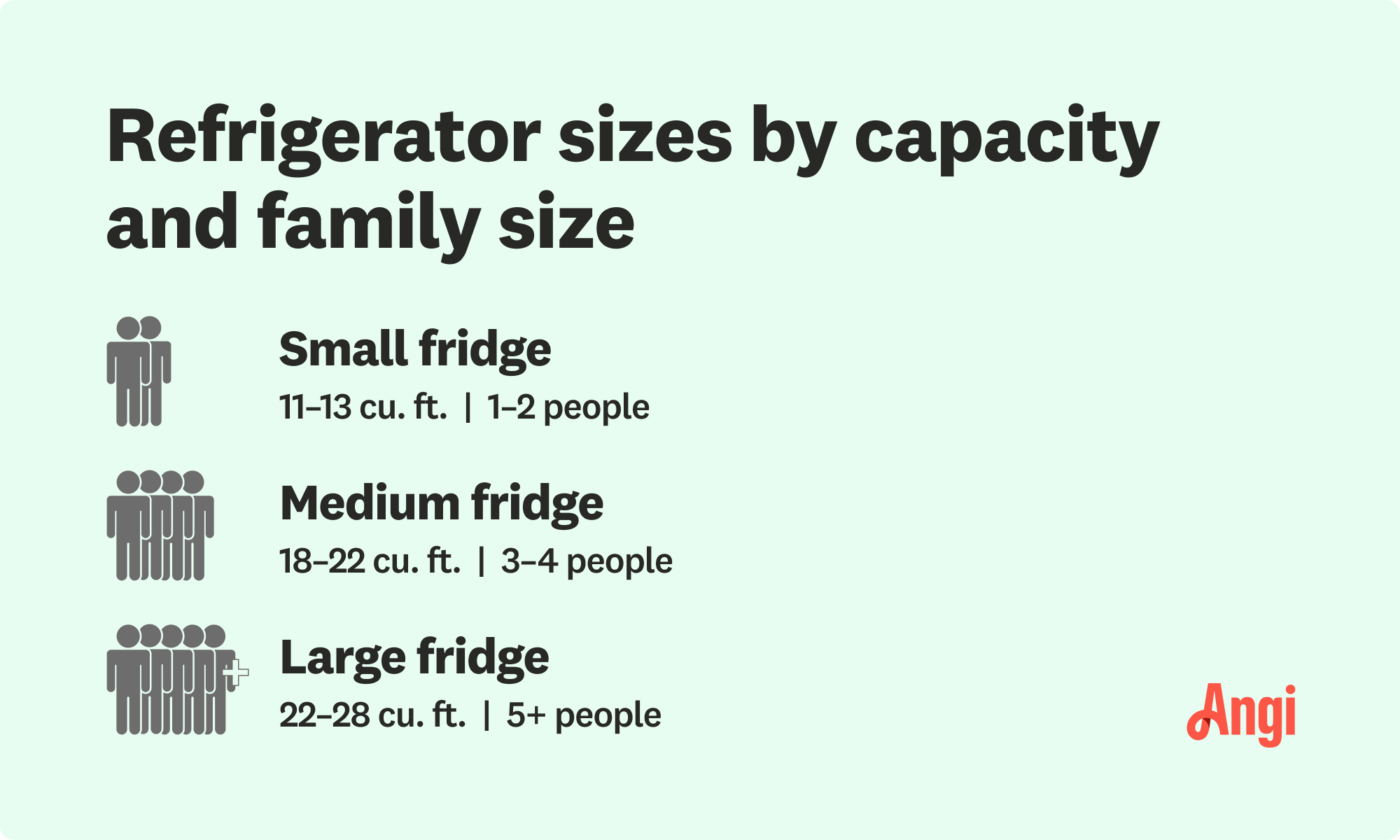
In addition to considering the dimensions of refrigerators, it's useful to know the capacity of a new fridge in cubic feet—in other words, how much food it can hold. The rule of thumb is that each adult in your home needs 4 to 6 cubic feet of refrigerator space. Depending on the size of your household, you’ll need:
1 to 2 people: 4–13 cubic feet
3 to 4 people: 14–24 cubic feet
5 or more people: 25 or more cubic feet
So, how do you choose a refrigerator size based on the number of people and cubic feet capacity? Here's how the numbers line up:
Small Refrigerators: Offer 11–13 cubic feet of space, ideal for 1 to 2 people.
Medium Refrigerators: Offer 18–22 cubic feet, ideal for a family of 3 or 4.
Large Refrigerators: Offer 22–28 cubic feet, ideal for a large family of 5 or more, or for active home chefs.
While researching new refrigerators for your home, you should take an in-depth look at the needs of your household and your size restrictions. Ask yourself the following questions:
Are you planning to grow your family in the near future?
Do you prefer standard-depth refrigerators for more floor space or counter-depth refrigerators for a built-in look?
Are you an aspiring chef who likes to cook and has a lot of food on hand?
Do you have the space for a large refrigerator?
Will the fridge you’re considering fit through all of the doorways that lead into your kitchen?
Will the doors or drawers open without being obstructed when the fridge is in place?
If you’re considering a counter-depth fridge, will the cabinets around the fridge get in the way of the door hinges?
Does the fridge you’re considering have the storage you need for the specific foods you buy often?
Does the fridge have adjustable storage options to grow with your family or dietary needs?
How much will it cost to maintain the proper refrigerator temperature for the fridge size I’m considering?

Once you’ve measured your space (see the next section for how to do so) and considered important factors, such as household size and how much storage you need, you’ll likely have many options when searching for refrigerators by dimensions. Keep in mind that standard-depth refrigerators average 30 to 36 inches deep, and counter-depth averages 23 to 29 inches deep.
It’s important to remember that “counter-depth” refrigerators aren’t all the same depth, as the name might imply. Whether you’re buying a counter-depth or standard-depth fridge, make sure you measure your space and choose a depth that works with your specific cabinets and countertops.
Refrigerators with top freezers tend to fall between 65 and 69 inches high, between 23 and 36 inches wide, and between 24 and 33 inches deep. These models tend to be a bit smaller than bottom freezer refrigerators, making them the best options for small spaces and small families, usually one to four people.
Refrigerators with bottom freezer compartments are usually a little bigger than those with a freezer on top. They usually stand between 67 and 70 inches tall, have a width of 29 to 33 inches and a depth of 24 to 33 inches. Bottom freezers are a little larger because they usually have a taller freezer section, meaning they could be a better option for you if you want more frozen food storage.
If you’re looking for midsized capacity refrigerators, french doors with freezers on the bottom are a great option. These fridges have two refrigerator doors that open in the middle away from each other, so they tend to be a little wider than single-door models. These are perfect for households consisting of one to five people or more and have average measurements are 67 to 70 inches high, 30 to 36 inches wide, and 29 to 35 inches deep.
Finally, households of five or more people that require large-capacity storage options should choose a side-by-side refrigerator. While these fridges have larger overall capacities, the storage is split almost evenly between the fridge and freezer. Perfect for buying, cooking, and storing in bulk, the average measurements are 67 to 72 inches high, 30 to 36 inches wide, and 29 to 35 inches deep.
When purchasing a new refrigerator, you’ll want to ensure that you measure the space within your kitchen correctly. If you’re unsure how to measure your space, you can hire a handyperson to help with this step. Alternatively, you can follow these guidelines to get the most accurate measurements possible.
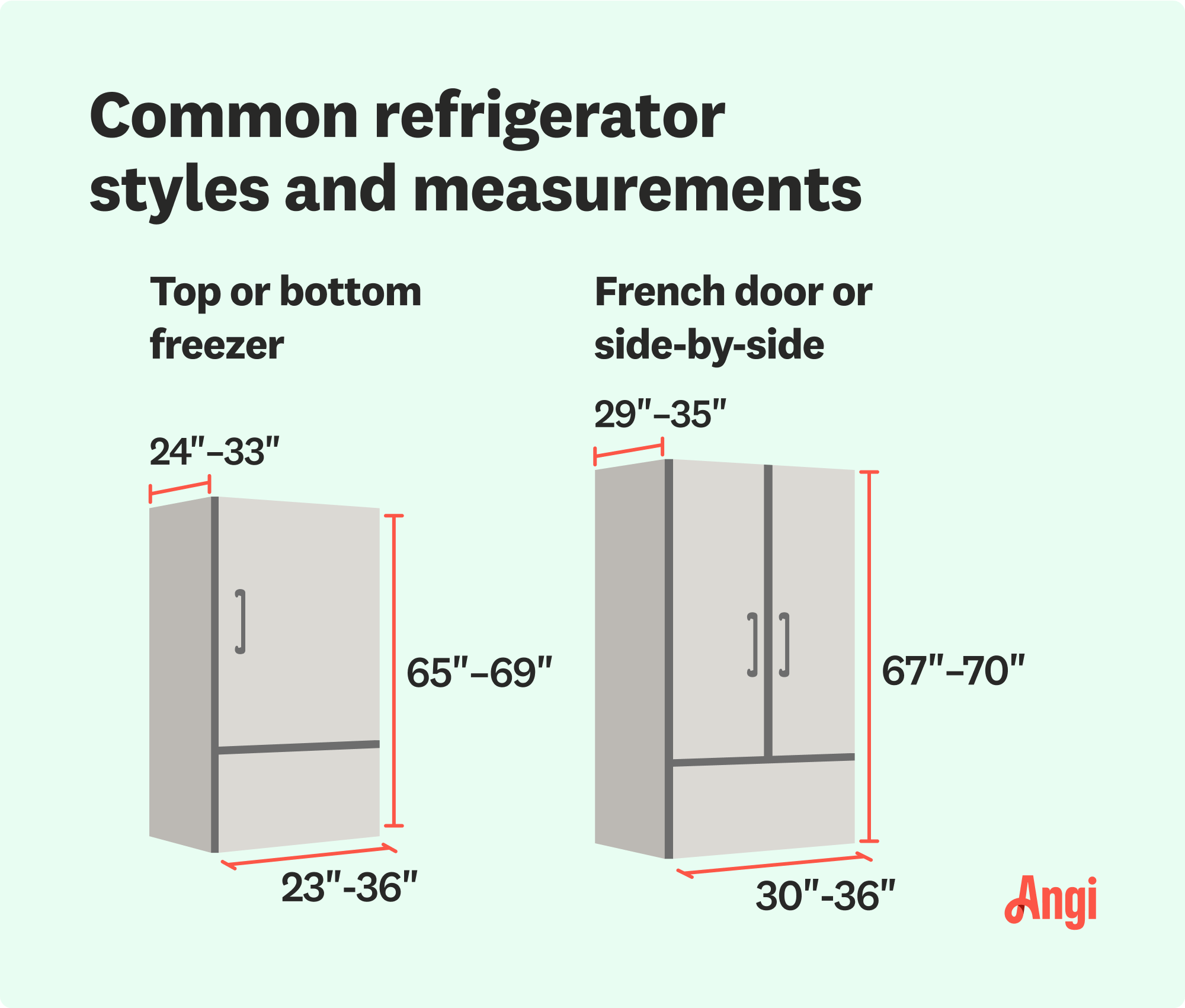
Refrigerators come in different styles and sizes. Here are some common dimensions to expect from different styles:
Top or bottom freezer fridge: 65’’-69’’ height, 24’’-33’’ depth, 23’’-36’’ width
French door or side-by-side fridge: 67’’-70’’ height, 29’’-35’’ depth, 30’’-36’’ width
Start by measuring three points—the width of your refrigerator space at the countertop, the area beneath the upper cabinets, and the base of the cabinets. Take the widest measurement, and add at least 1/2 inch on each side for ventilation.

Measure from the floor to the lowest point under the upper set of cabinets. You’ll need at least 1 to 2 inches of overhead space for ventilation.
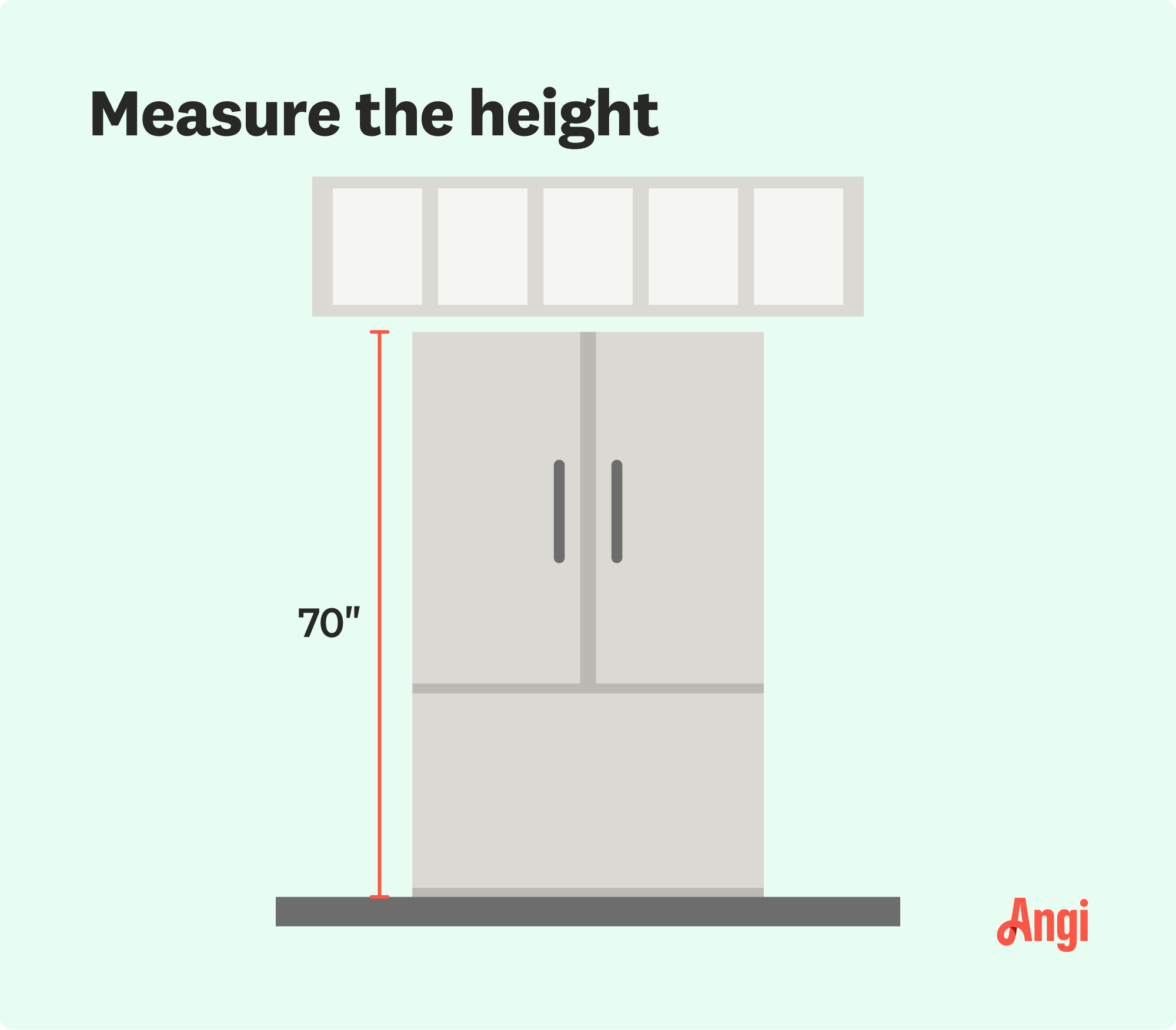
Start at the back wall and measure to the front edge of your cabinets. For standard-depth models, you can also measure up to 6 inches past your cabinets. Leave at least 1 to 2 inches of room at the back for proper ventilation and space for your power cord and ice maker line to run.

Whether you choose a standard-depth or counter-depth refrigerator, ensure that the hinges and doors won’t swing into cabinetry, islands, or walls when opening. Allow 2 inches of space between the hinge and the wall.
As noted above, air must circulate on each side of the refrigerator to prevent overworking and thus overheating. To account for ventilation, add at least 1/2 inch to the two sides of the fridge, 2 inches between the back of the fridge and the wall, and 1 to 2 inches between the top of the fridge and overhead storage or the ceiling.
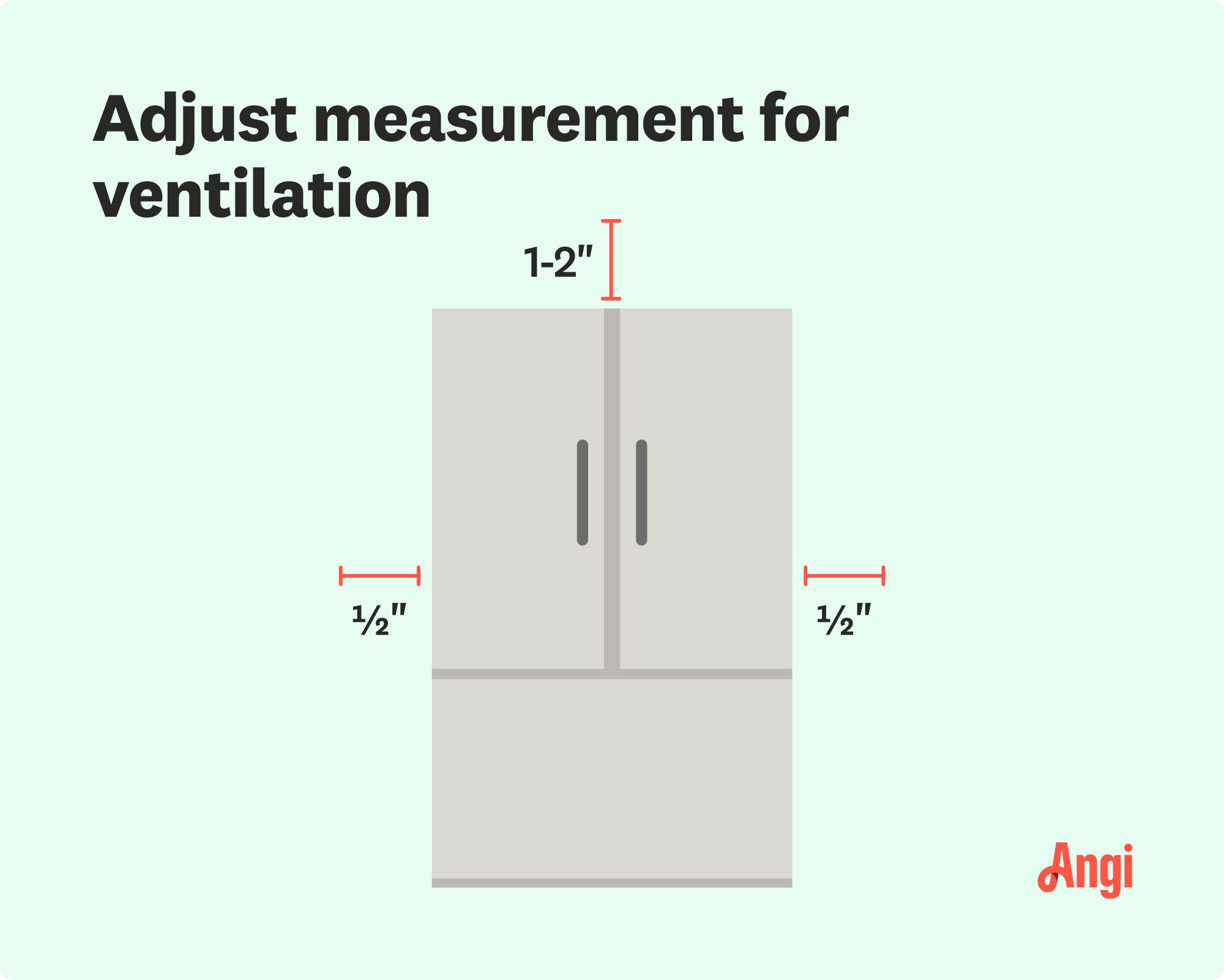
Once you have your chosen spot for your refrigerator, you should make a plan for its pathway into that spot. It’s a large appliance, so it’s useful to measure doorways before delivery and confirm that the unit has a way into your kitchen without knocking down shelves or scratching any walls. Tip: you can temporarily remove the refrigerator doors to reduce the depth by six inches.
Keep in mind that a new refrigerator may require an upgraded electrical outlet. When pulling out your old refrigerator, check to see if you should call an electrician near you to upgrade your outlet before installing your new refrigerator.
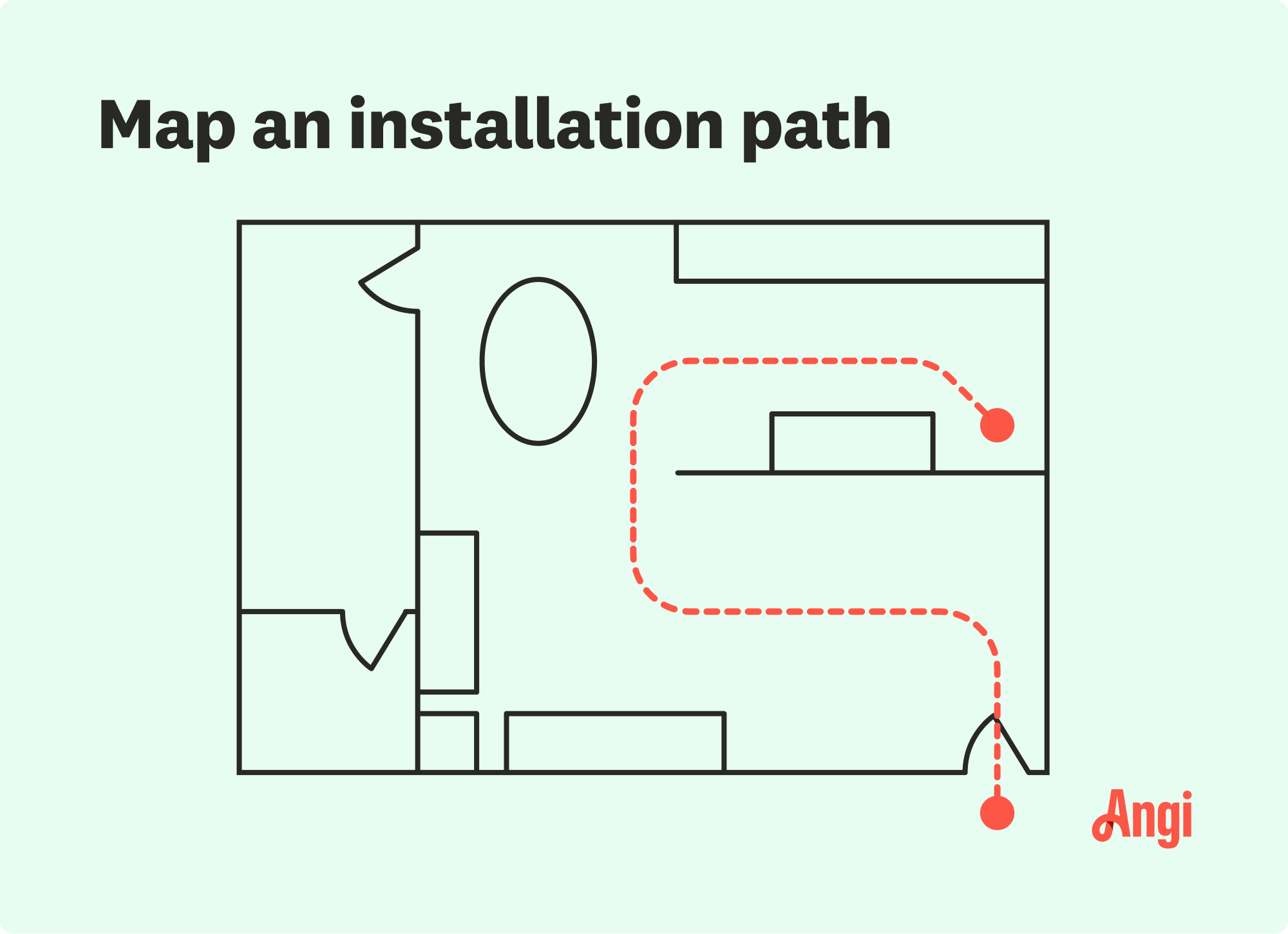
You’ll likely be paying for delivery and installation of your fridge. The cost to install a new appliance is usually around $200, but it’s worth it because takes the pressure off of you to move and install your new appliance. Before you order your fridge, though, you should walk through the following steps so that you’re prepared and know what to expect on the delivery day:
Measure your fridge space carefully and purchase a new fridge that will fit your dimensions.
Measure doorways leading into your kitchen from the exterior to ensure the fridge will fit into your home.
If your old fridge didn't call for these, check to see if your new fridge requires a new outlet or a water line for an ice maker. If so, have an electrician and/or plumber in before delivery to install the necessary hookups.
Confirm with your delivery team if they will be hauling the old fridge away.
Confirm whether or not your installation includes connection of the water line for the ice maker, if applicable. If you miss this step, a refrigerator repair service near you might be able to help.
Purchase any add-on kits necessary for ice maker connection.
Once you’ve ordered your new fridge and are ready to take delivery of it, there are a few things you’ll want to do to prepare on the day of the delivery:
Empty the fridge and freezer. You can temporarily store food items in a cooler if necessary.
Pull the old fridge out from the wall. Place a moving blanket or other soft mat under the front of the fridge to avoid scratching the floor.
Clean behind the fridge to remove dirt, pet hair, dust, and other debris.
Clear a path from your home’s exterior to the place where your fridge will be installed.
Confirm that the ice maker was connected, if applicable.
After installation, double check that all of the doors and drawers open without obstruction.
Ginny Bartolone contributed to this piece.
From average costs to expert advice, get all the answers you need to get your job done.

Discover the average dishwasher installation cost, key price factors, and tips to save on your project. Get transparent, expert-backed estimates.

A wood stove can add warmth and ambiance to your home, but is it in your budget? Discover average wood-burning stove installation costs in this guide.

Dryer repair costs as little as $10, but sometimes, replacing your dryer is more cost-effective. But if you have to make repairs, here’s how much it’ll cost.

Using your stove can cause smoke, smells, and grease to build up in your kitchen and home. Find out how much CFM your range hood needs to kick them to the curb.

Short on kitchen counter space? Learn how to install a microwave over a stove in 10 simple steps in this how-to guide.

Looking to extend the life and increase the efficiency of your dishwasher? Learn how to clean a dishwasher drain to enjoy a clean, dry load every time.